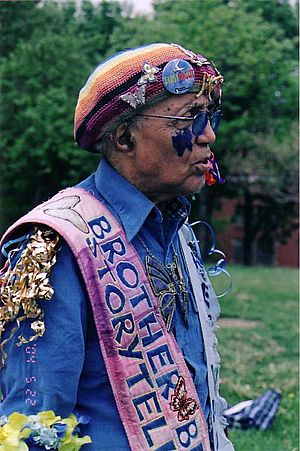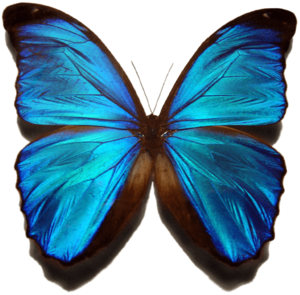Brother Blue facts for kids
Quick facts for kids
Brother Blue
|
|
|---|---|

Photo by Pete Lee
|
|
| Born |
Hugh Morgan Hill
July 12, 1921 Cleveland, Ohio, U.S.
|
| Died | November 3, 2009 (aged 88) Cambridge, Massachusetts, U.S.
|
| Education | Harvard University (BA) Yale University (MFA) Union Institute and University (PhD) |
| Occupation | Storyteller, actor, educator |
| Spouse(s) | Ruth Edmonds |
Hugh Morgan Hill (July 12, 1921 – November 3, 2009), known as Brother Blue, was a famous American storyteller, actor, and educator. He was also a musician and street performer who mostly worked in the Boston area.
Brother Blue served in the United States Army during World War II from 1943 to 1946. After his service, he went to Harvard College and earned a degree in 1948. He then studied at the Yale School of Drama and later earned a PhD from the Union Institute.
He often performed at storytelling festivals across the U.S. and traveled to places like England, Russia, and the Bahamas. However, he was most known for performing on the streets of Cambridge, especially in Harvard Square. Both the cities of Boston and Cambridge officially named him their "Official Storyteller."
In 2009, Brother Blue received the W. E. B. Du Bois Medal from Harvard University. This award is named after W. E. B. Du Bois, the first African American to get a PhD from Harvard. Brother Blue's wife, Ruth Edmonds Hill, accepted the award for him after he passed away.
Brother Blue always encouraged people to tell "stories that change the world." He believed stories should come from the heart, saying, "If it's not from your heart, don't tell it." He passed away in Cambridge, Massachusetts, when he was 88 years old.
Contents
Early Life and Education
Hugh Hill was born in Cleveland, Ohio. He grew up in a lively church environment in the 1920s and 1930s. His grandfather had been enslaved, and his father shared many stories about this time. The Hills lived in a poor area of Cleveland. Brother Blue remembered his childhood as tough, saying he was "like a flower who grew up in rocky soil." He discovered his talent for storytelling during Sunday church services. He continued to share stories when he taught Sunday school.
Brother Blue went to Harvard on a scholarship. There, he won the Boylston Prize for reciting a speech by Toussaint Louverture, a leader of a slave rebellion in Haiti. He also won the Walt Whitman International Media Competition for performing parts of The Autobiography of Malcolm X.
He first wanted to become a lawyer, like the famous American Civil Liberties attorney Clarence Darrow. But his passion for storytelling led him to the Yale School of Drama instead. He later earned his doctorate in Divinity, focusing on sacred storytelling.
The Blue Butterfly Symbol
Brother Blue and his wife Ruth were known for their symbol: the blue butterfly. This was inspired by the blue morpho butterfly, which is found in South America. One of Brother Blue's most famous stories was about a caterpillar's journey and its amazing change into a butterfly. He also knew that in ancient Greek culture, the butterfly was linked to the soul.
Brother Blue often wore clothes covered in butterfly symbols. He would even have blue butterflies painted on his cheeks and hands. Later in his life, he wore a large butterfly medallion around his neck. This was a gift from people who admired him and his wife. Butterflies also appeared on his books, banners, and even his staff. In the 1981 movie Knightriders, where he played Merlin, blue butterflies can be seen on his hands.
Brother Blue usually wore blue clothes, like blue turtlenecks or shirts and blue pants. He often wore a blue beret decorated with butterfly pins. He also wore a sash that said "BROTHER BLUE STORYTELLER." Ribbons were often tied to his shoulders, arms, and legs. He was also known for carrying bright blue balloons. Sometimes, he would take off his shoes during a performance to feel connected to the earth.
His business card in 2002 described him as "Storyteller, Street Poet, Soul Theater."
Brother Blue's Performances
Brother Blue had a special way of starting his stories. He would say, "From the middle of the middle of me," while pointing to his heart, "to the middle of the middle of you..." Then he would continue, "I am older than the oldest stories, I am the storyteller." One of his unique stories was about Muddy Duddy, a musician who could hear a harp playing from the earth.
His storytelling style used a lot of rhyme, rhythm, and making things up on the spot. He called himself a "street poet" and "God's fool." He told his own versions of Shakespeare's plays like King Lear and Romeo and Juliet. He also shared stories about his own life and his famous caterpillar story.
As an educator, Brother Blue taught at the Episcopal Divinity School and Harvard Divinity School. He also led the Harvard Storytelling Workshop with Ruth Hill. He even appeared on television through WGBH.
Brother Blue's performances and teachings often explored big ideas. These included birth, love, sadness, death, imagination, and the desire for change. He found inspiration in old stories, African and European legends, Shakespeare, and modern jazz. His stories often featured interesting characters, from heroes like Othello to simple figures like "This Little Girl."
His Teaching Style
Brother Blue believed in "appreciating" and "saying thank you" instead of criticizing. He felt it was important to celebrate people's "wonderfulness." He also avoided giving grades to his university students. He didn't like the idea of judging people's abilities or focusing too much on money.
Making things up on the spot, or improvisation, was a big part of his performances. He encouraged his students to do the same. He called it "cosmic jazz." He said, "I don't repeat myself, I don't write it down, you can't get it in a book."
Storytelling Traditions
Brother Blue felt that telling stories was a special calling. "I think I was anointed to be a storyteller," he said. He believed he could "blow the world away" with his stories. He wanted to tell "stories to change the world." He strongly felt that "Love will overcome all in this world. Love’s gonna win." He called storytelling a "sacred art."
Music and European Traditions
Brother Blue often used his harmonica and voice in his performances. He also sometimes used a tambourine or drums. He would snap his fingers, stomp, and dance, often barefoot.
He studied under Professor Albert Bates Lord at Harvard. Lord believed that Brother Blue was unique and didn't fit into any single storytelling tradition. Brother Blue often brought classic European figures into his stories. He mentioned people like Albert Einstein, Homer, Shakespeare, and St. Francis of Assisi. He said, "I bring Homer to the streets. I bring Sophocles." He believed storytellers should read widely and "know the new moves: You must be able to rap and be able to sing the blues!"
American and African Traditions
Brother Blue also included American figures in his stories, such as Bob Dylan, John Coltrane, and Robert F. Kennedy. He spoke about his desire to be "the black Clarence Darrow."
He also drew from African-American and African cultures. He used images like "a chicken with a busted wing," lions, and elephants. He spoke about Dr. Martin Luther King Jr. and B.B. King. Brother Blue often talked about skin color and racial issues, sharing his own experiences as an African American. He was a frequent guest at the U.S. National Association of Black Storytellers.
Awards and Honors
- W. E. B. Du Bois Medal, 2009.
- National Storytelling Network Lifetime Achievement Award, 1999. This award recognized his lasting contributions to storytelling in America.
- League for the Advancement of New England Storytelling (LANES) Brother Blue (Hugh Morgan Hill) and Ruth Hill Award, 2002. This annual award is named after him and his wife. It honors people who show amazing dedication to storytelling.
- Cambridge Center for Adult Education Anne Bradstreet Lifetime Achievement Award, 2000, for his contributions to poetry.
- Cambridge, Massachusetts, USA Peace Commission Peace and Justice Award, 1999.
- U.S. National Storytelling Association Circle of Excellence Award, 1996.
- U.S. National Association of Black Storytellers Esteemed Elder, 1995.
- U.S. National Association of Black Storytellers Zora Neale Hurston Award, 1986.
- Boston Music Awards “Best of Boston” award for Best Street Performance, 1982.
- Corporation for Public Broadcasting Local Programming Award, 1975.
- WGBH Special Citation for Outstanding Solo Performance on Public Radio, 1975.
- Walt Whitman International Media Competition winner, circa 1940s, for his performance of selections from The Autobiography of Malcolm X.
- Boylston Prize, circa 1945, for his recital of a speech by Toussaint Louverture.
- Brother Blue was also featured as the poster boy for the Spoleto Festival USA in Charleston, South Carolina.
Images for kids



